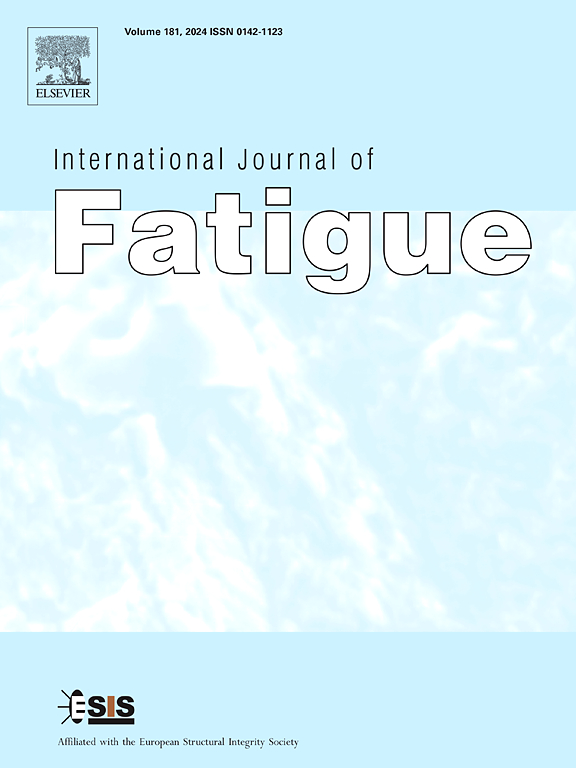Interpretable prediction of sample size–dependent fatigue crack formation lifetime using deep symbolic regression and polycrystalline plasticity models
IF 5.7
2区 材料科学
Q1 ENGINEERING, MECHANICAL
引用次数: 0
Abstract
Fatigue Indicator Parameters (FIPs), derived from cyclic intragranular and intergranular mechanical variables using the Crystal Plasticity Finite Element Method (CPFEM), can serve as surrogate measures of the driving force for fatigue crack formation within the first grain or nucleant phase. Simulating larger sample (i.e., increasing the number of grains) using CPFEM generally result in higher maximum FIP values, indicating a greater likelihood of fatigue crack initiation. However, the substantial computational demands of CPFEM limit its practical application in investigating the sample size effect on maximum FIPs. This study employs the recently developed Deep Symbolic Regression (DSR) algorithm to generate interpretable expressions linking sample size with the statistical characteristics of maximum FIPs in duplex Ti–6Al–4 V with random texture. These data–driven expressions obtained through DSR are systematically compared with predictions derived from the statistically grounded Extreme Value Theory (EVT), which suggests that the entire FIP dataset exceeding a threshold x0 converges to Gumbel distribution. The strong agreements found between DSR and EVT expressions not only validates the mathematical underpinnings of EVT but also demonstrates how EVT can elucidate the physical insights revealed by DSR. Building on this, we introduce a novel method, i.e., Regrouping of Maximum FIPs (RMF), to improve prediction reliability by mitigating the influence of the threshold x0 in EVT. Finally, by leveraging the statistical distribution of maximum FIPs derived from DSR, we forecast the sample size–dependent Fatigue Crack Formation Lifetime (FCFL), providing a robust tool for engineering applications.

基于深度符号回归和多晶塑性模型的随试样尺寸变化的疲劳裂纹形成寿命可解释预测
疲劳指示参数(FIPs)是利用晶体塑性有限元法(CPFEM)从循环晶内和晶间力学变量中得到的,可以作为第一粒或核相内疲劳裂纹形成驱动力的替代度量。使用CPFEM模拟较大的试样(即增加晶粒数)通常会导致更高的最大FIP值,这表明更有可能产生疲劳裂纹。然而,CPFEM的大量计算需求限制了其在研究最大FIPs的样本量效应方面的实际应用。本研究采用最近开发的深度符号回归(DSR)算法生成可解释的表达式,将样本量与具有随机纹理的双工Ti-6Al-4 V中最大FIPs的统计特征联系起来。通过DSR获得的这些数据驱动表达式与基于统计的极值理论(EVT)的预测进行了系统比较,结果表明,超过阈值x0的整个FIP数据集收敛于Gumbel分布。在DSR和EVT表达式之间发现的强烈一致性不仅验证了EVT的数学基础,而且还证明了EVT如何阐明DSR所揭示的物理见解。在此基础上,我们引入了一种新的方法,即最大FIPs重组(RMF),通过减轻EVT中阈值x0的影响来提高预测可靠性。最后,通过利用DSR得出的最大FIPs的统计分布,我们预测了样品尺寸相关的疲劳裂纹形成寿命(FCFL),为工程应用提供了一个强大的工具。
本文章由计算机程序翻译,如有差异,请以英文原文为准。
求助全文
约1分钟内获得全文
求助全文
来源期刊

International Journal of Fatigue
工程技术-材料科学:综合
CiteScore
10.70
自引率
21.70%
发文量
619
审稿时长
58 days
期刊介绍:
Typical subjects discussed in International Journal of Fatigue address:
Novel fatigue testing and characterization methods (new kinds of fatigue tests, critical evaluation of existing methods, in situ measurement of fatigue degradation, non-contact field measurements)
Multiaxial fatigue and complex loading effects of materials and structures, exploring state-of-the-art concepts in degradation under cyclic loading
Fatigue in the very high cycle regime, including failure mode transitions from surface to subsurface, effects of surface treatment, processing, and loading conditions
Modeling (including degradation processes and related driving forces, multiscale/multi-resolution methods, computational hierarchical and concurrent methods for coupled component and material responses, novel methods for notch root analysis, fracture mechanics, damage mechanics, crack growth kinetics, life prediction and durability, and prediction of stochastic fatigue behavior reflecting microstructure and service conditions)
Models for early stages of fatigue crack formation and growth that explicitly consider microstructure and relevant materials science aspects
Understanding the influence or manufacturing and processing route on fatigue degradation, and embedding this understanding in more predictive schemes for mitigation and design against fatigue
Prognosis and damage state awareness (including sensors, monitoring, methodology, interactive control, accelerated methods, data interpretation)
Applications of technologies associated with fatigue and their implications for structural integrity and reliability. This includes issues related to design, operation and maintenance, i.e., life cycle engineering
Smart materials and structures that can sense and mitigate fatigue degradation
Fatigue of devices and structures at small scales, including effects of process route and surfaces/interfaces.
 求助内容:
求助内容: 应助结果提醒方式:
应助结果提醒方式:


